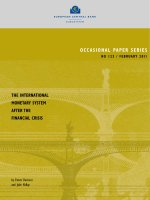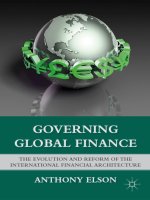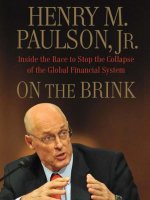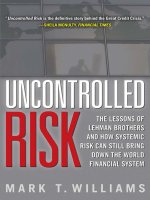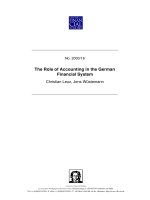the international financial system
Bạn đang xem bản rút gọn của tài liệu. Xem và tải ngay bản đầy đủ của tài liệu tại đây (123.93 KB, 30 trang )
Copyright 2011
Pearson Canada Inc.
20 -
1
Chapter 20
The International Financial System
Copyright 2011
Pearson Canada Inc.
20 -
2
Foreign Exchange Intervention
•
Chapter 19 looked at foreign exchange market
as though it were a free market without
interference.
•
Central banks engage in international financial
transactions (foreign exchange interventions)
to influence exchange rates
•
Use exchange rate analysis developed earlier
to examine impact of CB interventions
Copyright 2011
Pearson Canada Inc.
20 -
3
Foreign Exchange Intervention and the Money
Supply
•
A central bank’s purchase of domestic currency and
corresponding sale of foreign assets in the foreign exchange
market leads to an equal decline in its international reserves
and the monetary base
•
A central bank’s sale of domestic currency to purchase
foreign assets in the foreign exchange market results in an
equal rise in its international reserves and the monetary base
Bank of Canada Bank of Canada
Assets Liabilities Assets Liabilities
Foreign
Assets
-$1B Currency in
circulation
-$1B Foreign
Assets
-$1B Deposits with
Bank of
Canada
-$1B
(International
Reserves)
(International
Reserves)
(reserves)
Copyright 2011
Pearson Canada Inc.
20 -
4
Unsterilized Intervention
•
An unsterilized intervention (domestic
currency sale) leads to an increase in
international reserves, an increase in the
money supply, and a depreciation of the
domestic currency
•
The converse is true of an unsterilized
intervention in which domestic currency is
purchased.
Copyright 2011
Pearson Canada Inc.
20 -
5
Effect of a Sale of Dollars and a Purchase of
Foreign Assets
Copyright 2011
Pearson Canada Inc.
20 -
6
Sterilized Foreign Exchange Intervention
•
To counter the effect of the foreign exchange
intervention, conduct an offsetting open market
operation
•
There is no effect on the monetary base and no
effect on the exchange rate
Bank of Canada
Assets Liabilities
Foreign Assets Monetary Base
(International Reserves) -$1B (reserves) 0
Government Bonds +$1B
Copyright 2011
Pearson Canada Inc.
20 -
7
Balance of Payments
•
Current Account
–
International transactions
that involve currently
produced goods and
services
•
Trade Balance
•
Capital Account
–
Net receipts from capital
transactions
•
Sum of these two is the
official reserve
transactions balance
Current Account + Capital Account = net change in
government international reserves
Copyright 2011
Pearson Canada Inc.
20 -
8
Exchange Rate Regimes
•
Fixed exchange rate regime
–
Value of a currency is pegged relative to the value of one
other currency (anchor currency)
•
Floating exchange rate regime
–
Value of a currency is allowed to fluctuate against all other
currencies
•
Managed float regime (dirty float)
–
Attempt to influence exchange rates by buying and selling
currencies
Copyright 2011
Pearson Canada Inc.
20 -
9
Past Exchange Rate Regimes I
•
Gold standard
–
Fixed exchange rates
–
No control over monetary policy
–
Influenced heavily by production of gold and
gold discoveries
•
Bretton Woods System
–
Fixed exchange rates using U.S. dollar as
reserve currency
–
International Monetary Fund (IMF)
Copyright 2011
Pearson Canada Inc.
20 -
10
Past Exchange Rate Regimes II
•
Bretton Woods System (continued)
–
World Bank
–
General Agreement on Tariffs and Trade (GATT)
•
World Trade Organization
•
European Monetary System (EMS)
–
Exchange rate mechanism
Copyright 2011
Pearson Canada Inc.
20 -
11
Intervention in the Foreign Exchange Market Under Fixed Exchange
Rates
Copyright 2011
Pearson Canada Inc.
20 -
12
How a Fixed Exchange Rate Regime Works
•
When the domestic currency is overvalued, the
central bank must purchase domestic currency
to keep the exchange rate fixed; but as a
result, it loses international reserves
•
When the domestic currency is undervalued,
the central bank must sell domestic currency to
keep the exchange rate fixed; but as a result, it
gains international reserves
Copyright 2011
Pearson Canada Inc.
20 -
13
How Bretton Woods Worked
•
Exchange rates adjusted only when experiencing a
‘fundamental disequilibrium’ (large persistent deficits in
balance of payments)
•
Loans from IMF to cover loss in international reserves
•
IMF encourages contractionary monetary policies
•
Devaluation only if IMF loans are not sufficient
•
No tools for surplus countries
•
U.S. could not devalue currency
Copyright 2011
Pearson Canada Inc.
20 -
14
Managed Float
•
Hybrid of fixed and flexible
–
Small daily changes in response to market
–
Interventions to prevent large fluctuations
•
Appreciation hurts exporters and employment
•
Depreciation hurts imports and stimulates
inflation
•
Special drawing rights as substitute for gold
Copyright 2011
Pearson Canada Inc.
20 -
15
European Monetary System
•
8 members of EEC fixed exchange rates with
one another and floated against the U.S. dollar
•
ECU value was tied to a basket of specified
amounts of European currencies
•
Fluctuated within limits
•
Led to foreign exchange crises involving
speculative attack
Copyright 2011
Pearson Canada Inc.
20 -
16
Controls on Capital Outflows
•
Promote financial instability by forcing
a devaluation
•
Controls are seldom effective and may increase
capital flight
•
Lead to corruption
•
Lose opportunity to improve the economy
Copyright 2011
Pearson Canada Inc.
20 -
17
Controls on Capital Inflows
•
Lead to a lending boom and excessive risk
taking by financial intermediaries
•
Controls may block funds for productions uses
•
Produce substantial distortion and
misallocation
•
Lead to corruption
•
Strong case for improving bank regulation
and supervision
Copyright 2011
Pearson Canada Inc.
20 -
18
The IMF: Lender of Last Resort
•
Emerging market countries with poor central
bank credibility and short-run debt contracts
denominated in foreign currencies have limited
ability to engage in this function
•
May be able to prevent contagion
•
The safety net may lead to excessive risk taking
(moral hazard problem)
Copyright 2011
Pearson Canada Inc.
20 -
19
How Should the IMF Operate?
•
May not be tough enough
•
Austerity programs focus on tight
macroeconomic policies rather than financial
reform
•
Too slow, which worsens crisis and increases
costs
Copyright 2011
Pearson Canada Inc.
20 -
20
Direct Effects of the Foreign Exchange Market on the
Money Supply
•
Intervention in the foreign exchange market
affects the monetary base
•
U.S. dollar has been a reserve currency: monetary
base and money supply have been less affected
by foreign exchange market
Copyright 2011
Pearson Canada Inc.
20 -
21
Balance-of-Payments Considerations
•
Current account deficits in the U.S. suggest
that American businesses may be losing ability
to compete because the dollar is too strong
•
U.S. deficits mean surpluses in other countries
⇒ large increases in their international reserve
holdings ⇒ world inflation
Copyright 2011
Pearson Canada Inc.
20 -
22
Exchange Rate Considerations
•
A contractionary monetary policy will raise the
domestic interest rate and appreciate the
currency
•
An expansionary monetary policy will lower
interest rates and depreciate the currency
Copyright 2011
Pearson Canada Inc.
20 -
23
Advantages of Exchange-Rate Targeting
•
Contributes to keeping inflation under control
–
Ties inflation rate for internationally traded goods
to that found in anchor country
•
Automatic rule for conduct of monetary policy
–
Mitigates time-inconsistency problem
•
Simplicity and clarity
–
Easily understood by the public
Copyright 2011
Pearson Canada Inc.
20 -
24
Disadvantages of Exchange-Rate Targeting
•
Targeting country cannot pursue independent
monetary policy and use it to respond to
domestic shocks.
•
Shocks to the anchor country are directly
transmitted to the target country.
•
Open to speculative attacks on currency
•
Weakens the accountability of policymakers as
the exchange rate loses value as signal
Copyright 2011
Pearson Canada Inc.
20 -
25
Exchange-Rate Targeting for Industrialized Countries
•
Some countries are unable to successfully manage
monetary policy.
–
E.g. Italy prior to EMU
•
Benefits of centrally managed monetary policy
outweigh loss of control
•
Encourages integration of the domestic economy
with its neighbors


